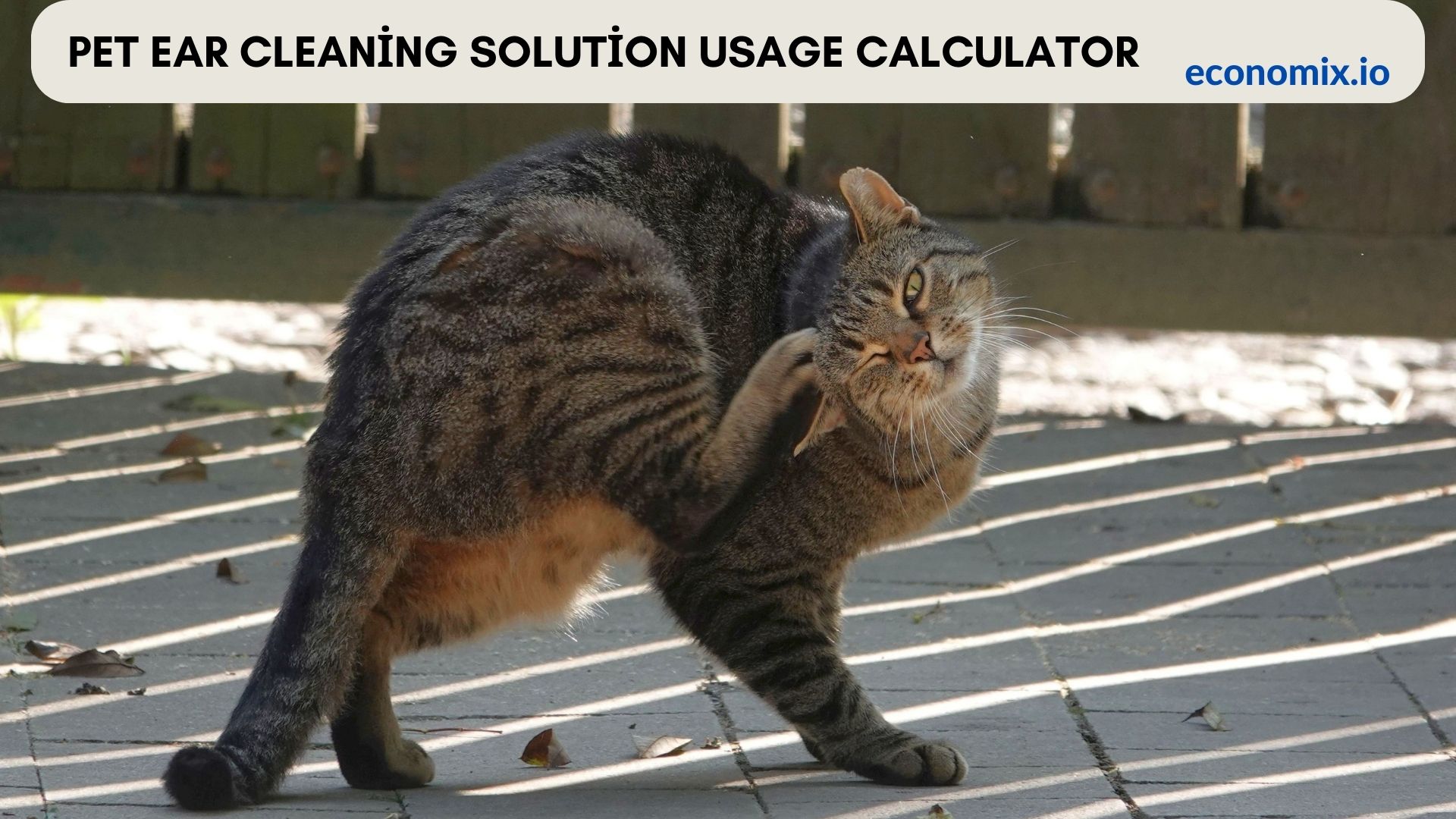Table of Contents
- Choosing the Best Ear-Cleaning Solution for Your Pet
- Can You Use Hydrogen Peroxide on Pets’ Ears?
- How to Know When Your Pet’s Ears Need Cleaning
- How Much Ear-Cleaning Solution Should You Use?
- Simplify Cleaning with the Pet Ear Cleaning Solution Usage Calculator
- Best Practices for Cleaning Your Pet’s Ears
- Making Pet Care Easier
Estimated reading time: 6 minutes. Last updated: December 25, 2024.
How Much Ear Cleaning Solution Does Your Pet Need?

Ear cleaning is an essential part of maintaining your pet’s overall hygiene and health, yet it’s often a task that raises many questions for pet parents. From choosing the right cleaning solution to determining how much to use, knowing the answers can make this routine task much easier. Here’s everything you need to know about ear-cleaning solutions to ensure your furry friend’s ears stay clean, healthy, and infection-free.
“Prevention is better than cure.”
Choosing the Best Ear-Cleaning Solution for Your Pet
One of the most common concerns among pet owners is selecting the right ear-cleaning solution. The key is to use a veterinary-approved product specifically designed for pets. These solutions are formulated to gently clean your pet’s ears without causing irritation or harm.
Popular Choices:
- Vetoquinol Ear Cleaning Solution: A trusted product for routine ear cleaning and soothing irritation.
- TrizULTRA + Keto Flush: Known for its antifungal properties, this solution is excellent for pets prone to yeast infections.
It’s important to avoid homemade remedies, as they can contain harmful or irritating ingredients. While the internet is filled with DIY options, nothing beats the reliability and safety of a vet-recommended ear-cleaning solution.
Can You Use Hydrogen Peroxide on Pets’ Ears?
The answer is a resounding no. While hydrogen peroxide is a staple in many households, it’s not suitable for cleaning your pet’s ears. This chemical can irritate the sensitive tissues of the ear canal and lead to long-term damage with repeated use.
Instead, stick to veterinary-formulated solutions. These are designed to clean effectively while maintaining the natural pH balance of your pet’s ears. Protecting your pet's delicate ear tissue is key to preventing pain and discomfort.
How to Know When Your Pet’s Ears Need Cleaning
Understanding when to clean your pet’s ears can prevent over-cleaning, which might irritate their ears. While some pets require regular ear maintenance, others naturally keep their ears clean with minimal intervention.
Look out for these common signs that your pet’s ears need cleaning:
- Frequent head shaking or scratching: This might indicate discomfort caused by wax or debris buildup.
- Redness or swelling: A sign of irritation or infection that needs attention.
- Unusual odors: A yeasty or unpleasant smell is often associated with an ear infection.
- Visible debris or wax: If you notice dirt or wax accumulation, it’s time for a gentle cleaning session.
If your pet displays any of these symptoms, clean their ears promptly using a vet-approved solution. However, if symptoms persist, consult your veterinarian.
How Much Ear-Cleaning Solution Should You Use?
The amount of solution needed depends on your pet’s size and the instructions provided with the product. As a general rule of thumb, 5–10 milliliters per ear is usually sufficient for most pets.
Follow these steps to ensure you’re using the right amount:
- Hold your pet’s ear flap upright and gently pour the recommended quantity into the ear canal.
- Massage the base of the ear for 20–30 seconds to help the solution break up debris.
- Allow your pet to shake their head, which will naturally expel loosened dirt and excess solution.
Always double-check the product’s label for specific dosage guidelines and avoid overusing the solution. Too much liquid can make the ear canal damp, creating a breeding ground for infections.
Simplify Cleaning with the Pet Ear Cleaning Solution Usage Calculator
To take the guesswork out of ear cleaning, the Pet Ear Cleaning Solution Usage Calculator helps you estimate the exact amount of solution you’ll need over time. Enter details such as cleaning frequency and the solution amount per session, and the calculator will provide insights into your monthly and yearly usage.
For instance:
- Cleaning once a week and using 10 milliliters per session would require 40 milliliters per month and 480 milliliters annually.
This information ensures you’re never caught off guard and helps plan your supplies efficiently.
By using this tool, you can streamline your pet care routine and focus on what matters most—keeping your furry friend healthy and happy.
Best Practices for Cleaning Your Pet’s Ears
- Inspect First: Before cleaning, check for redness, swelling, or unusual discharge. If these are present, consult your vet instead of proceeding with cleaning.
- Use Veterinary-Approved Solutions: Stick to safe, tested products like Vetoquinol or TrizULTRA + Keto Flush.
- Be Gentle: Use cotton balls or gauze to clean the outer ear. Avoid cotton swabs, which can push debris further into the ear canal or damage the eardrum.
- Monitor Frequency: Clean your pet’s ears only when needed to prevent over-cleaning. Weekly or biweekly is sufficient for most pets, but some may need more or less frequent care.
- Reward Your Pet: A treat and praise after cleaning will help your pet associate ear care with positive experiences.

Making Pet Care Easier
Caring for your pet’s health doesn’t have to feel overwhelming. With the right approach and tools, you can transform routine tasks into manageable and even enjoyable experiences. The Pet Ear Cleaning Solution Usage Calculator is just one of many resources designed to simplify your pet care routine.
In addition to managing ear care, you can explore tools like the Dog Tooth Brushing Time Cost Calculator to plan your dental hygiene routine for your dog. Regular tooth brushing not only improves your pet’s oral health but also helps prevent more serious issues, saving you time and expense in the long run.
For those who want to manage grooming more efficiently, the Dog Shampoo Consumption Cost Calculator can help you estimate the cost of your pet’s bath time over weeks, months, or even years. It’s a great way to plan your supplies and maintain a consistent grooming schedule.
Together, these tools make it easier than ever to keep your pet looking and feeling their best. With consistent care and a little planning, you can strengthen the bond between you and your furry friend while ensuring their health and happiness. Embrace the benefits of smart pet care—start using these calculators today to make every moment count!
- American Kennel Club "How to Clean a Dog’s Ears."
- PetMD "6 Best Ear Cleaners for Dogs in 2025, Recommended by Vets."
- Veterinary Secrets "Ear Cleaning for Dogs and Cats."